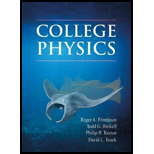
Concept explainers
(a)
The average output power per hydroelectric plant.
Answer to Problem 102QAP
The average output power per hydroelectric plant is
Explanation of Solution
Given:
Concept Used:
Theory of power for transfer of energy.
Calculation:
According to theory of power for transfer of energy:
Conclusion:
The average output power per hydroelectric plant is
(b)
The total mass of water flowed over the dams during
Answer to Problem 102QAP
The total mass of water flowed over the dams during
Explanation of Solution
Given:
Concept Used:
Interpreting potential energy.
Calculation:
Potential energy
As per given condition each plant is efficient of converting
On replacing the values, we get
Conclusion:
The total mass of water flowed over the dams during
(c)
The average mass of water per dam and average volume of water per dam that provides the mechanical energy to generate the electricity.
Answer to Problem 102QAP
The average mass of water per dam is
Explanation of Solution
Given:
Concept Used:
Interpreting potential energy.
.
Calculation:
Potential energy
As per given condition each plant is efficient of converting
On replacing the values, we get
On replacing the value, we get
The average volume of water per dam that provides the mechanical energy to generate the electricity is:
Conclusion:
The average mass of water per dam is
(d)
The gallons that the gasoline for the
Answer to Problem 102QAP
The gallons that the gasoline for the
Explanation of Solution
Given:
A gallon of gasoline contains
Concept Used:
Interpreting potential energy.
Calculation:
We know that energy is given as:
A gallon of gasoline contains
So, the gallons that the gasoline for the
Conclusion:
The gallons that the gasoline for the
Want to see more full solutions like this?
Chapter 6 Solutions
COLLEGE PHYSICS
- In simplest way, For each quadratic relation, find the zeros and the maximum or minimum. a) y = x 2 + 16 x + 39 b) y = 5 x2 - 50 x - 120arrow_forwardIn simplest terms and step by step Write each quadratic relation in standard form, then fi nd the zeros. y = - 4( x + 6)2 + 36arrow_forwardIn simplest terms and step by step For each quadratic relation, find the zeros and the maximum or minimum. 1) y = - 2 x2 - 28 x + 64 2) y = 6 x2 + 36 x - 42arrow_forward
- Write each relation in standard form a)y = 5(x + 10)2 + 7 b)y = 9(x - 8)2 - 4arrow_forwardIn simplest form and step by step Write the quadratic relation in standard form, then fi nd the zeros. y = 3(x - 1)2 - 147arrow_forwardStep by step instructions The path of a soccer ball can be modelled by the relation h = - 0.1 d 2 + 0.5 d + 0.6, where h is the ball’s height and d is the horizontal distance from the kicker. a) Find the zeros of the relation.arrow_forward
- Algebra & Trigonometry with Analytic GeometryAlgebraISBN:9781133382119Author:SwokowskiPublisher:Cengage


 College Algebra (MindTap Course List)AlgebraISBN:9781305652231Author:R. David Gustafson, Jeff HughesPublisher:Cengage Learning
College Algebra (MindTap Course List)AlgebraISBN:9781305652231Author:R. David Gustafson, Jeff HughesPublisher:Cengage Learning Algebra: Structure And Method, Book 1AlgebraISBN:9780395977224Author:Richard G. Brown, Mary P. Dolciani, Robert H. Sorgenfrey, William L. ColePublisher:McDougal Littell
Algebra: Structure And Method, Book 1AlgebraISBN:9780395977224Author:Richard G. Brown, Mary P. Dolciani, Robert H. Sorgenfrey, William L. ColePublisher:McDougal Littell Glencoe Algebra 1, Student Edition, 9780079039897...AlgebraISBN:9780079039897Author:CarterPublisher:McGraw Hill
Glencoe Algebra 1, Student Edition, 9780079039897...AlgebraISBN:9780079039897Author:CarterPublisher:McGraw Hill





